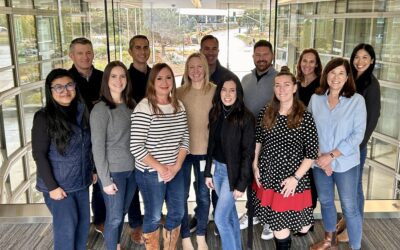In other words, I advocate for a design thinking (or human-centered) approach.
In July 2022, my opinions and passion for the use of design thinking approaches in learning design heightened to a new level. That’s when my husband, Kirk, was diagnosed with severe heart failure. Two emotions occupied ALL of our heart space and head space as soon as Kirk’s diagnosis was made: FEAR and GRIEF. We were blindsided. Kirk, a very fit and active 60-year-old, went from healthy to “seriously ill heart patient” overnight. He had noticed a handful of symptoms in the previous few weeks that he kept dismissing because we were in the throes of caring for his dying mom. He dismissed these symptoms as related to grief and stress until after her funeral. Kirk later visited his primary care doctor, which launched a flurry of tests that led to a 7 p.m. phone call by a cardiologist, telling Kirk that his echocardiogram test had revealed severe heart failure, and the cause unknown.

Sharon Boller and her husband Kirk celebrating their first vacation post-diagnosis at Zion National Park in Utah in April 2022.
This diagnosis meant that Kirk’s heart ejection fraction (a measure of his heart’s ability to pump oxygen-filled blood back to the rest of his body) was between 10% and 15%; normal heart ejection fraction is between 55% and 73%. Kirk’s left ventricle was very enlarged (aka cardiomyopathy), and his mitral valve located within the left ventricle was heavily leaking blood. (That night we had to look up cardiomyopathy, mitral valve, and the entire anatomy of the heart.)
From there followed a tsunami of time-consuming and terrifying tests, blood draws, doctors’ visits, and chemistry experiments to see what dosages of which medicines my husband could tolerate. As a subsequent heart failure specialist put it to us later, if we imagined Kirk’s heart as a 6-cylinder car engine, his engine was operating on only about 1.5 of those 6 cylinders. Kirk was prescribed several drugs (right now he’s on 12 different ones), and a few of his medicines have very scary-sounding potential side effects. That first evening phone call was the first snowflake of the eventual blizzard of new terminology and lifestyle changes. Truly our lives—and the plans we had—changed overnight. Because of the severity of his failure, we had no idea how long of a future Kirk had, or of what quality.
You might be asking, what does all this have to do with learning?
After decades of designing learning for others and trying to educate clients about the issue of “cognitive load” and how much learning someone could absorb, I was living it. The emotional weight of a life-threatening health diagnosis can make the task of learning feel like trying to scale a mountain with little to no mountain climbing knowledge or experience. As I grappled with the shock of the diagnosis, I immediately looked for a patient and caregiver education program that could guide us. I discovered there are millions of pieces of information but little coherent, cohesive patient education. The advanced heart failure clinic where Kirk was sent had nothing to offer us in the way of patient education programs or materials, despite being a top-rated cardiac facility. We were on our own.
My background as a consultant, instructional designer, and learning architect gave me a definite edge over most caregivers or patients who need to learn quickly. I dove into the research; over a series of weeks, I figured out some of what we needed to know about severe heart failure. It took many weeks of effort to sort through various sources and learn how to even ask for what we needed. I turned to Reddit for support, when it seemed that clinics themselves could set up a vehicle for this. My journey took hours and hours of effort and stress that could have been saved or made far easier with a well-crafted learning journey and resources. More importantly, for most people who lack my background, a well-crafted journey can improve clinical outcomes, reduce patient fear and stress, and reduce healthcare costs overall.
I would like to make patient education better. So, I used a few design thinking tools to envision the ideal learning journey for those facing a diagnosis of heart failure. My goal is to share this ideal journey with hospital and healthcare systems to help them see what’s possible and consider how it can improve patient experiences and outcomes. Here’s what I included:
Empathy Map – This map is a brain dump of the feelings, thoughts, visuals, and words swirling around me, as well as my pain points and motivators as a caregiver. This tool helps you “start with the heart” when designing education or training.
Experience Map – This map articulates actual experiences coupled with descriptions of magical and miserable moments at each step. Again, by attending to the magical and miserable moments, a good designer can intentionally maximize the magical and minimize the miserable.
Learning Journey Map – This is the map for the learning experience I WISHED for. This journey starts with the heart. It addresses emotional needs as well as the need for knowledge and behavior change. It is patient–/caregiver– focused rather than clinically focused.
These maps were created in a Miro Board. Each map can be exported as an image if people want to save them for easy reference later.
This journey is not yet a reality; it is a vision. My hope is that this journey inspires healthcare executives and educators to consider what’s possible.




